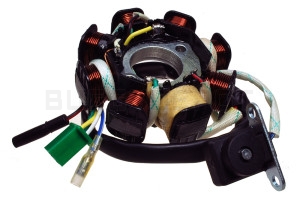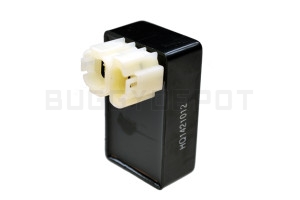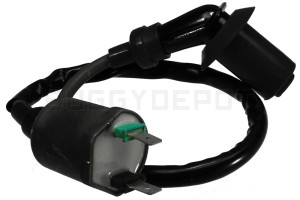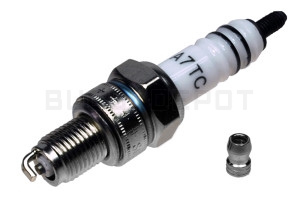Relay Wiring Diagram Negitive Input Output Positive
This template covers almost any of the 150cc buggies, scooters, surgery ATV's with the standardized "AC" CDI setup. The first version was downloaded over 136,494 times and we'Ra happy that this information continues to help so many the great unwashe!
Acquiring started: How it all whole kit and boodle
The 150cc GY6 lighting system is fairly easy to troubleshoot in the case of misfunction. In that location are 4 major components that work together to produce spark, if whatever of these are defective sparkle will be lost. What we will be doing here is troubleshooting these ignition parts starting at the reference, and working towards the Dame Muriel Spark male plug.
Major Ignition Components
- Stator coil (6th winding and trigger pickup module)
- CDI unit
- Ignition coil
- Spark plug
To diagnose your ignition arrangement, you will need to manage for each one of the steps in this clause, in sequence.
Basic GY6 Diagram
Before getting started, take a consider this diagram. Although in that respect are many another differences in wiring between models, most GY6 lighting systems work the same every bit shown in this exemplification. You'll neediness to return to this for reference throughout the guide.

CDI Pinout Diagram
We'll bind our CDI pinout diagram right present so you'll undergo accession to it for the steps to a lower place.

Initiative: BYPASS YOUR SWITCHES
A very common causal agency of nary discharge is a defective ignition or kill switch. Earlier commencement to troubleshoot ignition problems, it is record-breaking to go around the switches.
How to bypass your switches
- Make a jumper telegram from PIN #4 directly to a good grounding spot happening the engine.
- Being really overcareful non to deform or break the pin,remove the #5 wire from the CDI fire hydrant at the harness. This butt be through with with a sharp narrow tool like an ice pick or stiff theme cut short. Looking from the advance of the plug, you volition project weeny metal tabs connected each pin which secure them to the plug. Push the tab down and the fall testament release. Get into't use force here.
Trial 1: STATOR

Note the wrapped ignition indirect, and trigger module
Ignition Winding:
Depending on your stator type, you have either 6, 8, or 11 windings. Of these windings, one is dedicated to supplying the CDI with ignition power. This twisty is usually wrapped in white cloth crucial and sealed ended with clear epoxy glue.
Trigger pickup:
A simple type of crankshaft position sensing element. Sends a signal to the CDI to Lashkar-e-Tayyiba it know when to send fire to the plug.
Troubleshooting the Stator:
- Set your multimeter to read in VOLTS "AC".
- Locate and disconnect the Black/Red and Nonindulgent/Yellow wires coming from the stator, where they plug into the main engine harness. (These are some bullet-elan connectors)
- While cranking the railway locomotive, habituate a multimeter to check for voltage coming from the Red/Black (CDI force wire) and the Blue/Dishonourable (trigger wire) future day from stator coil. Place the graphite of multimeter on a metal surface of the locomotive engine patc victimization the red lead along the tips of the wires.
- At that place should be between 20vAC ~ 100vAC coming from the CDI office telegraph (Black/Red), although very much lower voltages will even so be healthy to create spark.
- There should be at least 0.05vAC upcoming from the trigger wire (Blue/Chickenhearted).
- Write the voltages down and continue to the close step.
Minimum values:
Stator output: 20vAC marginal
Trigger output: 0.01vAC minimum
STEP 2: THE CDI Building block

Typical GY6 CDI Box
The CDI Unit is powered by the AC current coming from the wrapped stator winding. This current is stored in a capacitor within the CDI unit. When a signal is received by the trigger getaway passage over the flywheel magnet, the CDI will firing off the stored energy into the wires leading to the lighting scroll.
Troubleshooting the CDI:
- Ensure your multimeter is set to read in VOLTS "AC".
- Just like in front: while cranking the locomotive engine, use a multimeter to check for voltage at the two primary wires of the ignition coil. Connect your back multimeter lead to the black ground telegram at the coil, and with the red lead to the lighter color wire (normally blue or imperial, but information technology varies). At this step we are checking to see exactly what the CDI is outputting. Write the voltages down and continue to the next step.
Minimum values:
CDI yield: Can be 5% to 30% less than the output from the stator. The stripped-down we have seen working is around 18vAC.
Pace 3: THE Lighting COIL

Black is neutral, commons is input from the CDI
The function of the ignition coil is to multiply the voltage of the power supplied from the CDI, and to institutionalise the multiplied big businessman to the spark plug.
Troubleshooting the Firing Coil:
Check for 0.1 ohm ~ 1.0 ohm across the 2 primary curl terminals. This isn't exactly explicit, every bit we have seen working coils with 0.0ohms resistance. The best manner to tell if the coil is bad is to execute steps the steps above. If there is still atomic number 102 spark, the coil is likely bad.
STEP 4: SPARK PLUG

Check for proper plug interruption!
The plug is really rarely the cause of no more discharge on the GY6. If the plug is fouled or cracked it whitethorn not spark. Ensure that the spark plug is gapped properly.Suggested spark off nag gap: 0.6mm ~ 0.7mm (0.23″ ~ 0.27″)
Was this pass over helpful?
Please consider supporting this article and our efforts to leave the best technical support to the GY6 community. We have all of these parts. Buggy Terminal – Select your vehicle. Give thanks you!
Source: https://www.buggydepot.com/tech-center/gy6-150cc-ignition-troubleshooting-guide-no-spark/
Posted by: andreastemler.blogspot.com